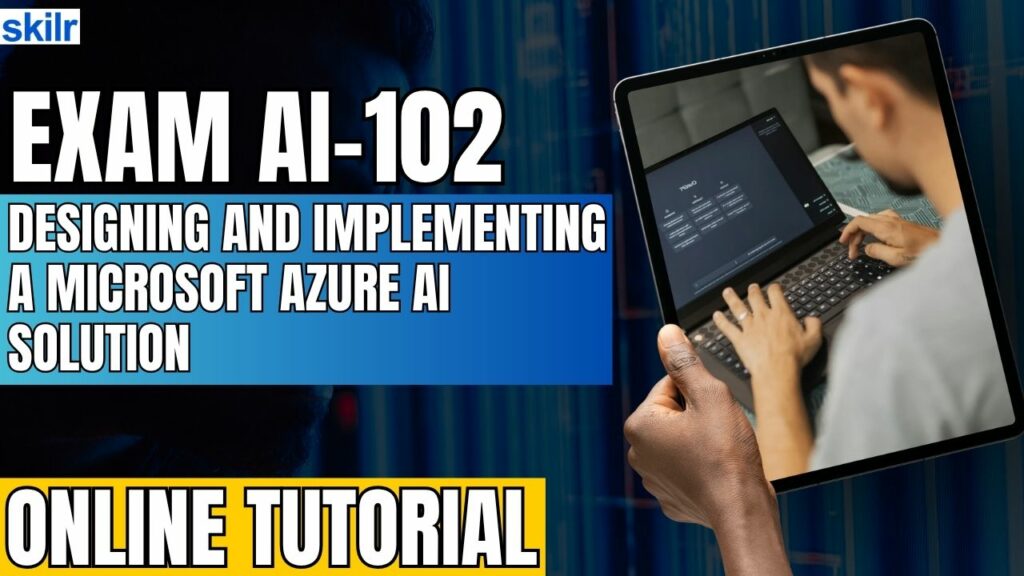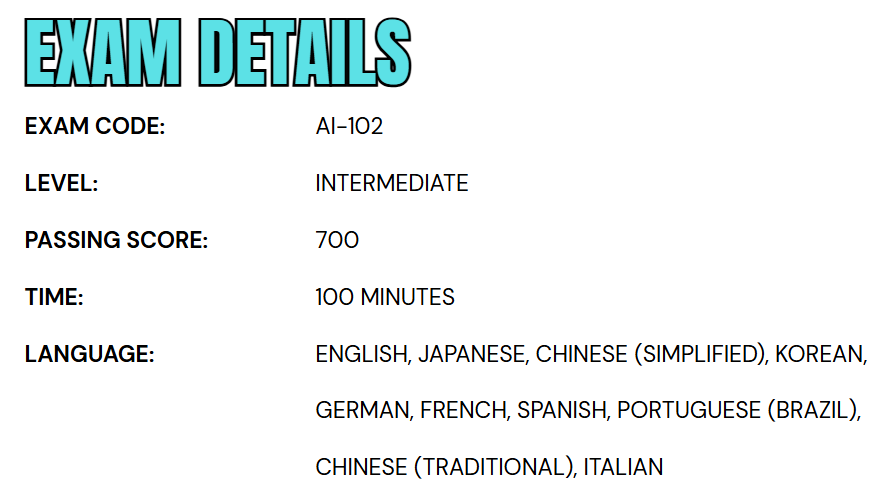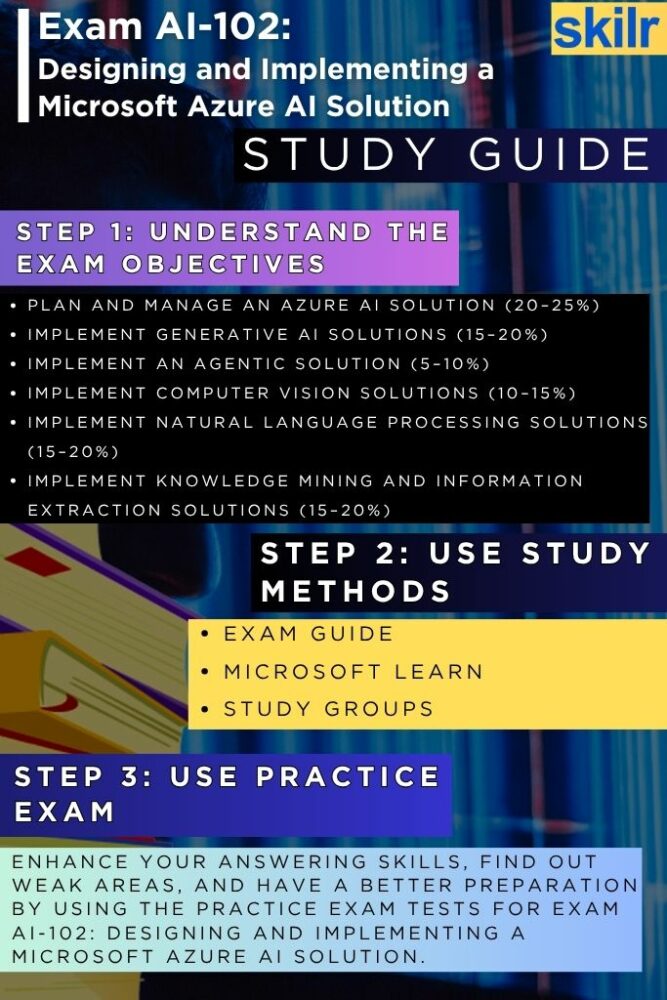
The Exam AI-102: Designing and Implementing a Microsoft Azure AI Solution is tailored for professionals working as Azure AI Engineers. These individuals are responsible for designing, developing, deploying, and maintaining AI solutions on the Microsoft Azure platform. The role requires a strong understanding of Azure services and tools, as well as a collaborative mindset to work across multidisciplinary teams.
Key Responsibilities
Azure AI Engineers are involved throughout the entire lifecycle of AI solution development. This includes:
- Requirement Gathering & Solution Design
- Collaborating with stakeholders to define business needs and translating them into scalable AI solution architectures.
- Development
- Creating intelligent applications using Azure AI services, integrating various APIs, SDKs, and machine learning models.
- Deployment & Integration
- Implementing and integrating AI models into existing or new applications with a focus on security, scalability, and performance.
- Maintenance & Optimization
- Monitoring deployed solutions to ensure reliability, tuning performance, and updating models or components as needed.
- Operational Oversight
- Ensuring continuous monitoring, logging, and diagnostics of AI solutions to maintain optimal functionality and compliance.
Collaboration Across Teams
As an Azure AI Engineer, you work closely with a variety of professionals to deliver end-to-end AI solutions. These include:
- Solution Architects – Translating architectural blueprints into technical implementations.
- Data Scientists & Engineers – Integrating machine learning models and handling data pipelines.
- IoT Specialists & Software Developers – Embedding AI into IoT ecosystems and applications.
- Infrastructure Administrators – Managing deployment environments and supporting resource optimization.
Technical Skill Set
To succeed in this role and pass the AI-102 exam, you should be proficient in:
- Programming Languages:
- Python
- C#
- Azure AI Services & APIs:
Leveraging REST APIs and Azure SDKs to build AI-powered solutions for:- Image and video analysis
- Natural language processing (NLP)
- Knowledge mining
- Generative AI
Foundational Knowledge Areas
An Azure AI Engineer should have a firm understanding of the following:
- Azure AI Ecosystem:
- Familiarity with the various components of the Azure AI portfolio and how they interconnect.
- Data Storage Solutions:
- Knowledge of Azure’s data storage offerings and their use cases in AI development.
- Responsible AI Practices:
- Applying ethical AI principles, ensuring fairness, transparency, and accountability in AI systems.
Exam Details

The Exam AI-102: Designing and Implementing a Microsoft Azure AI Solution is designed for individuals at an intermediate level aiming to pursue a career as an Azure AI Engineer. This proctored, closed-book assessment has a duration of 100 minutes and may include interactive tasks that simulate real-world AI engineering scenarios. To pass the exam, candidates must achieve a minimum score of 700 out of 1000. The exam is available in multiple languages, including English, Japanese, Simplified Chinese, Traditional Chinese, Korean, German, French, Spanish, Brazilian Portuguese, and Italian, making it accessible to a global audience. Candidates who require accommodations, such as additional time, assistive technologies, or modifications to the exam format—may submit a request for support to ensure an inclusive testing experience.
Course Outline
The exam covers the following topics:
1. Planning and Managing an Azure AI Solution (20-25%)
Select the appropriate Azure AI service
- Selecting the proper service for a generative AI solution
- Selecting the appropriate service for a computer vision solution
- Select the proper service for a natural language processing solution
- Select the appropriate service for a speech solution (Microsoft Documentation: What is the Speech service?)
- Select the appropriate service for an information extraction solution
- Select the proper service for a knowledge mining solution
Plan, create and deploy an Azure AI service
- Plan for a solution that meets Responsible AI principles (Microsoft Documentation: What is Responsible AI?)
- Creating an Azure AI resource
- Choosing the appropriate AI models for your solution
- Deploying AI models using the appropriate deployment options
- Installing and utilizing the appropriate SDKs and APIs
- Determine a default endpoint for a service
- Integrating Azure AI services into a continuous integration and continuous delivery (CI/CD) pipeline
- Planning and implementing a container deployment
Manage, monitor and secure an Azure AI service
- Monitoring an Azure AI resource
- Managing costs for Azure AI services
- Manage and protect account keys
- Manage authentication for an Azure AI Service resource
Implement AI solutions responsibly
- Implementing content moderation solutions
- Configuring responsible AI insights, including content safety
- Implementing responsible AI, including content filters and blocklists
- Preventing harmful behavior, including prompt shields and harm detection
- Designing a responsible AI governance framework
2. Implementing generative AI solutions (15–20%)
Build generative AI solutions with Azure AI Foundry
- Plan and prepare for a generative AI solution
- Deploy a hub, project, and necessary resources with Azure AI Foundry
- Deploy the appropriate generative AI model for your use case
- Implement a prompt flow solution
- Implement a RAG pattern by grounding a model in your data
- Evaluate models and flows
- Integrate your project into an application with Azure AI Foundry SDK
- Utilize prompt templates in your generative AI solution
Use Azure OpenAI Service to generate content
- Provision an Azure OpenAI Service resource
- Select and deploy an Azure OpenAI model
- Submit prompts to generate code and natural language responses
- Use the DALL-E model to generate images
- Integrate Azure OpenAI into your own application
- Use large multimodal models in Azure OpenAI
- Implement an Azure OpenAI Assistant
Optimize and operationalize a generative AI solution
- Configure parameters to control generative behavior
- Configure model monitoring and diagnostic settings, including performance and resource consumption (Microsoft Documentation: Diagnostic settings in Azure Monitor)
- Optimize and manage resources for deployment, including scalability and foundational model updates
- Enable tracing and collect feedback
- Implement model reflection
- Deploy containers for use on local and edge devices (Microsoft Documentation: Give Azure IoT Edge modules access to a device’s local storage)
- Implement orchestration of multiple generative AI models
- Apply prompt engineering techniques to improve responses
- Fine-tune an generative model (Microsoft Documentation: Customize a model with fine-tuning)
3. Implementing an agentic solution (5–10%)
Create custom agents
- Understand the role and use cases of an agent
- Configure the necessary resources to build an agent
- Create an agent with the Azure AI Agent Service
- Implement complex agents with Semantic Kernel and Autogen
- Implement complex workflows including orchestration for a multi-agent solution, multiple users, and autonomous capabilities
- Test, optimize and deploy an agent
4. Implementing computer vision solutions (10–15%)
Analyze images
- Select visual features to meet image processing requirements
- Detect objects in images and generate image tags
- Include image analysis features in an image processing request (Microsoft Documentation: Image Analysis)
- Interpret image processing responses
- Extract text from images using Azure AI Vision
- Convert handwritten text using Azure AI Vision
Implement custom computer vision models
- Choose between image classification and object detection models
- Label images
- Train a custom image model, including image classification and object detection
- Evaluate custom vision model metrics
- Publish a custom vision model
- Consume a custom vision model
- Build a custom vision model code first
Analyze videos
- Use Azure AI Video Indexer to extract insights from a video or live stream
- Use Azure AI Vision Spatial Analysis to detect presence and movement of people in video
5. Implementing Natural Language Processing Solutions (15-20%)
Analyze and translate text
- Extract key phrases and entities
- Determine sentiment of text
- detect the language used in the text (Microsoft Documentation: Detect language with Text Analytics)
- Detect personally identifiable information (PII) in text
- Translate text and documents by using the Azure AI Translator service
Process and translate speech
- Integrate generative AI speaking capabilities in an application
- Implement text-to-speech and speech-to-text using Azure AI Speech (Microsoft Documentation: text-to-speech, Custom Voice, speech-to-text)
- Improve text-to-speech by using Speech Synthesis Markup Language (SSML)
- Implement custom speech solutions with Azure AI Speech
- Implement intent and keyword recognition with Azure AI Speech (Microsoft Documentation: Recognize intents with the Speech service and LUIS)
- Translate speech-to-text by using the Azure AI Speech service (Microsoft Documentation: speech-to-text)
Implement custom language models
- Create intents, entities, and add utterances
- Train evaluate, deploy, and test a language understanding model (Microsoft Documentation: deploy a model, Train your conversational language understanding model)
- Optimize, backup, and recover language understanding model (Microsoft Documentation: What is Language Understanding (LUIS)?)
- Consume a language model from a client application
- Create a question answering project (Microsoft Documentation: Create, test, and deploy a custom question answering project)
- Add question-and-answer pairs and import sources for question answering
- Train, test, and publish a knowledge base (Microsoft Documentation: Test your knowledge base in QnA Maker, Create, train, and publish your QnA Maker knowledge base, Publish the knowledge base)
- Create a multi-turn conversation (Microsoft Documentation: create multiple turns of a conversation)
- Add alternate phrasing and chit-chat to a knowledge base (Microsoft Documentation: Add additional alternatively-phrased questions, Add alternate questions, Add Chit-chat to a knowledge base)
- Export a knowledge base (Microsoft Documentation: Migrate a knowledge base using export-import)
- Create a multi-language question answering solution
- Implement custom translation, including training, improving, and publishing a custom model
6. Implementing knowledge mining and information extraction solutions (15–20%)
Implement an Azure AI Search solution
- Provision an Azure AI Search resource, create an index, and define a skillset
- Create data sources and indexers (Microsoft Documentation: Create Data Source)
- Implement custom skills and include them in a skillset
- create and run an indexer (Microsoft Documentation: Creating indexers in Azure Cognitive Search)
- Query an index, including syntax, sorting, filtering, and wildcards (Microsoft Documentation: Simple query syntax in Azure Cognitive Search, Lucene query syntax in Azure Cognitive Search, Querying in Azure Cognitive Search)
- Manage knowledge store projections, including file, object, and table projections
- Implement semantic and vector store solutions
Implement an Azure AI Document Intelligence solution
- Provision a Document Intelligence resource
- Use prebuilt models to extract data from documents
- Implement a custom document intelligence model
- Train, test, and publish a custom document intelligence model
- Create a composed document intelligence model
Extract information with Azure AI Content Understanding
- Create an OCR pipeline to extract text from images and documents
- Summarize, classify, and detect attributes of documents
- Extract entities, tables, and images from documents
- Process and ingest documents, images, videos, and audio with Azure AI Content Understanding
Microsoft AI-102 Exam FAQs
Microsoft Certification Exam Policies
Microsoft maintains a robust set of certification exam policies to ensure the integrity, consistency, and global credibility of its certification program. These policies are in place to provide a fair and secure testing environment for all candidates, whether the exam is taken online or at an authorized test center. Adhering to these guidelines helps preserve the industry-wide respect associated with Microsoft certifications.
Exam Retake Policy
If a candidate does not pass the exam on their first attempt, a minimum waiting period of 24 hours is required before retaking the test. For subsequent attempts—from the second to the fifth—a mandatory 14-day waiting period must be observed between each try. To maintain testing fairness and standardization, Microsoft limits candidates to a maximum of five attempts within a 12-month period, starting from the date of the initial exam.
Rescheduling and Cancellation Guidelines
Microsoft provides candidates with flexible options for managing their exam appointments. Rescheduling or canceling an exam at least six business days before the scheduled date incurs no penalty. However, if changes are made within five business days of the appointment, a rescheduling or cancellation fee will apply. Candidates who either miss their exam or cancel less than 24 hours before the scheduled time will forfeit the entire exam fee. In exceptional cases—such as emergencies or documented accessibility requirements—Microsoft may offer accommodations or policy exceptions upon review.
Microsoft AI-102 Exam Study Guide

1. Understand the Exam Objective
To effectively prepare for the AI-102 exam, it is essential to thoroughly understand the exam objectives. These objectives outline the key skills and knowledge areas that candidates are expected to master. The AI-102 exam evaluates your ability to design and implement AI solutions using Microsoft Azure services. It covers areas such as data processing, model deployment, integration of AI solutions into various applications, and ensuring security and scalability. Familiarizing yourself with the exam objectives allows you to focus your preparation on the most relevant topics, ensuring that you are well-equipped to tackle both theoretical questions and practical scenarios that may appear during the exam.
2. Use the Microsoft Official Learning Path
Utilizing the Microsoft Official Learning Path is a crucial step in preparing for the AI-102 exam. This comprehensive resource is designed to guide candidates through the key concepts and skills required for the exam. It covers all essential topics, including designing and implementing AI solutions with Azure services, data processing, model deployment, and ensuring the security and scalability of AI systems. By following the official learning path, you can ensure that your preparation is aligned with the exam objectives, providing structured and detailed insights that will help you effectively prepare for both theoretical and practical aspects of the exam. The modules are:
- Basics of Azure AI Services
- Developing generative AI apps in Azure AI Foundry
- Steps for Developing Generative AI solutions with Azure OpenAI Service
- Developing AI agents on Azure
- Understand natural language processing solutions with Azure AI Services
- Developing computer vision solutions in Azure
- Implementing knowledge mining with Azure AI Search
- Developing solutions with Azure AI Document Intelligence
3. Become Part of Study Groups
Joining study groups can significantly enhance your preparation for the AI-102 exam. Engaging with a community of learners allows you to share insights, clarify doubts, and discuss key concepts, all of which contribute to a deeper understanding of the material. Study groups often provide a collaborative environment where you can explore different approaches to solving problems related to designing and implementing AI solutions with Azure services, data processing, and model deployment. By participating in group discussions and problem-solving activities, you can stay motivated, receive valuable feedback, and reinforce your knowledge, making your exam preparation more effective and comprehensive.
4. Take Microsoft AI-102 Exam Practice Tests
Taking Microsoft AI-102 exam practice tests is an essential part of your preparation strategy. These practice exams simulate the real test environment, allowing you to familiarize yourself with the types of questions and the exam format. By taking these tests, you can assess your understanding of key topics such as designing and implementing AI solutions with Azure services, data processing, and model deployment. Practice tests also help identify areas where you may need to improve, giving you the opportunity to focus your study efforts on weaker sections. Additionally, they help you manage time effectively and reduce exam-day anxiety, ensuring that you are well-prepared for the actual exam.


